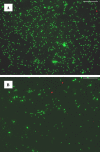Different Cellular Origins and Functions of Extracellular Proteins from Escherichia coli O157:H7 and O104:H4 as Determined by Comparative Proteomic Analysis
- PMID: 27208096
- PMCID: PMC4959213
- DOI: 10.1128/AEM.00977-16
Different Cellular Origins and Functions of Extracellular Proteins from Escherichia coli O157:H7 and O104:H4 as Determined by Comparative Proteomic Analysis
Abstract
Extracellular proteins play important roles in bacterial interactions with the environmental matrices. In this study, we examined the extracellular proteins from Escherichia coli O157:H7 and O104:H4 by tandem mass spectrometry. We identified 500 and 859 proteins from the growth media of E. coli O157:H7 and O104:H4, respectively, including 371 proteins common to both strains. Among proteins that were considered specific to E. coli O157:H7 or present at higher relative abundances in O157:H7 medium, most (57 of 65) had secretion signal sequences in their encoding genes. Noticeably, the proteins included locus of enterocyte effacement (LEE) virulence factors, proteins required for peptidyl-lipoprotein accumulation, and proteins involved in iron scavenging. In contrast, a much smaller proportion of proteins (37 of 150) that were considered specific to O104:H4 or presented at higher relative abundances in O104:H4 medium had signals targeting them for secretion. These proteins included Shiga toxin 2 subunit B and O104:H4 signature proteins, including AAF/1 major fimbrial subunit and serine protease autotransporters. Most of the abundant proteins from the growth medium of E. coli O104:H4 were annotated as having functions in the cytoplasm. We provide evidence that the extensive presence of cytoplasmic proteins in E. coli O104:H4 growth medium was due to biological processes independent of cell lysis, indicating alternative mechanisms for this potent pathogen releasing cytoplasmic contents into the growth milieu, which could play a role in interaction with the environmental matrices, such as pathogenesis and biofilm formation.
Importance: In this study, we compared the extracellular proteins from two of the most prominent foodborne pathogenic E. coli organisms that have caused severe outbreaks in the United States and in Europe. E. coli O157:H7 is a well-studied Shiga toxigenic foodborne pathogen of the enterohemorrhagic pathotype that has caused numerous outbreaks associated with various contaminated foods worldwide. E. coli O104:H4 is a newly emerged Shiga toxigenic foodborne pathogen of the enteroaggregative pathotype that gained notoriety for causing one of the most deadly foodborne outbreaks in Europe in 2011. Comparison of proteins in the growth medium revealed significant differences in the compositions of the extracellular proteins for these two pathogens. These differences may provide valuable information regarding the cellular responses of these pathogens to their environment, including cell survival and pathogenesis.
Copyright © 2016, American Society for Microbiology. All Rights Reserved.
Figures

Similar articles
-
Fitness of Enterohemorrhagic Escherichia coli (EHEC)/Enteroaggregative E. coli O104:H4 in Comparison to That of EHEC O157: Survival Studies in Food and In Vitro.Appl Environ Microbiol. 2016 Oct 14;82(21):6326-6334. doi: 10.1128/AEM.01796-16. Print 2016 Nov 1. Appl Environ Microbiol. 2016. PMID: 27542931 Free PMC article.
-
DNA microarray-based assessment of virulence potential of Shiga toxin gene-carrying Escherichia coli O104:H7 isolated from feedlot cattle feces.PLoS One. 2018 Apr 30;13(4):e0196490. doi: 10.1371/journal.pone.0196490. eCollection 2018. PLoS One. 2018. PMID: 29708991 Free PMC article.
-
Survival and interaction of Escherichia coli O104:H4 on Arabidopsis thaliana and lettuce (Lactuca sativa) in comparison to E. coli O157:H7: Influence of plant defense response and bacterial capsular polysaccharide.Food Res Int. 2018 Jun;108:35-41. doi: 10.1016/j.foodres.2018.03.029. Epub 2018 Mar 11. Food Res Int. 2018. PMID: 29735067
-
Escherichia coli O104:H4 Pathogenesis: an Enteroaggregative E. coli/Shiga Toxin-Producing E. coli Explosive Cocktail of High Virulence.Microbiol Spectr. 2014 Dec;2(6). doi: 10.1128/microbiolspec.EHEC-0008-2013. Microbiol Spectr. 2014. PMID: 26104460 Review.
-
Infections with verotoxin-producing escherichia coli O157:H7 and other serotypes, including the outbreak strain O104:H4.Acta Clin Belg. 2012 Jan-Feb;67(1):7-12. doi: 10.2143/ACB.67.1.2062619. Acta Clin Belg. 2012. PMID: 22480032 Review.
Cited by
-
Identification of novel salt tolerance-associated proteins from the secretome of Enterococcus faecalis.World J Microbiol Biotechnol. 2022 Aug 8;38(10):177. doi: 10.1007/s11274-022-03354-w. World J Microbiol Biotechnol. 2022. PMID: 35934729
-
Comparison of Enzyme Secretion and Ferulic Acid Production by Escherichia coli Expressing Different Lactobacillus Feruloyl Esterases.Front Microbiol. 2020 Nov 3;11:568716. doi: 10.3389/fmicb.2020.568716. eCollection 2020. Front Microbiol. 2020. PMID: 33329424 Free PMC article.
-
Quantification of enterohemorrhagic Escherichia coli O157:H7 protein abundance by high-throughput proteome.PLoS One. 2018 Dec 31;13(12):e0208520. doi: 10.1371/journal.pone.0208520. eCollection 2018. PLoS One. 2018. PMID: 30596662 Free PMC article.
-
Identification of virulence-associated factors in Vibrio parahaemolyticus with special reference to moonlighting protein: a secretomics study.Int Microbiol. 2024 Jun;27(3):765-779. doi: 10.1007/s10123-023-00429-y. Epub 2023 Sep 13. Int Microbiol. 2024. PMID: 37702858
-
Overexpressed Proteins in Hypervirulent Clade 8 and Clade 6 Strains of Escherichia coli O157:H7 Compared to E. coli O157:H7 EDL933 Clade 3 Strain.PLoS One. 2016 Nov 23;11(11):e0166883. doi: 10.1371/journal.pone.0166883. eCollection 2016. PLoS One. 2016. PMID: 27880834 Free PMC article.
References
Publication types
MeSH terms
Substances
LinkOut - more resources
Full Text Sources
Other Literature Sources

